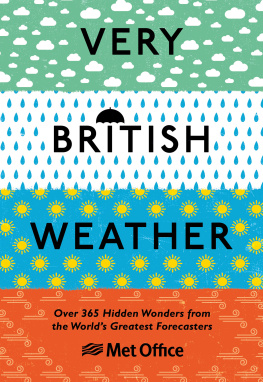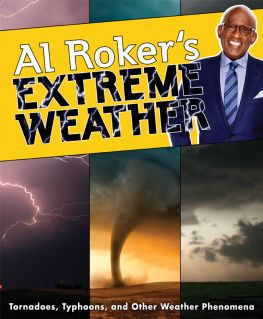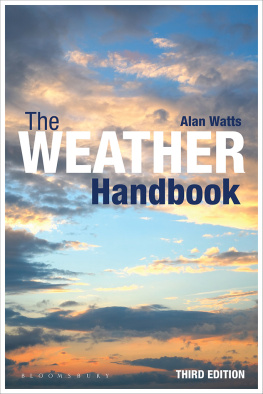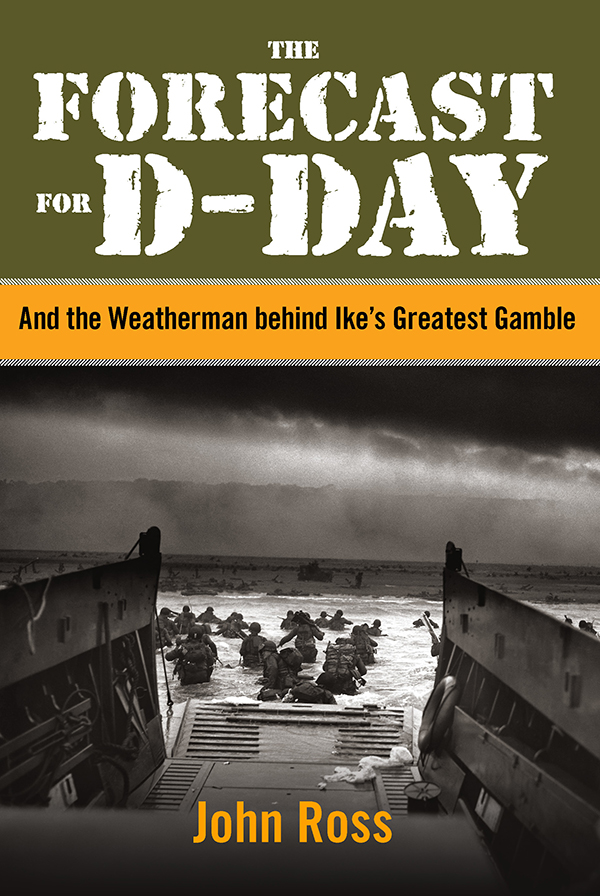The Forecast for D-day
And the Weatherman behind Ikes Greatest Gamble
John Ross

LYONS PRESS
Guilford, Connecticut
An imprint of Globe Pequot Press
Copyright 2014 by John Ross
ALL RIGHTS RESERVED. No part of this book may be reproduced or transmitted in any form by any means, electronic or mechanical, including photocopying and recording, or by any information storage and retrieval system, except as may be expressly permitted in writing from the publisher. Requests for permission should be addressed to Globe Pequot Press, Attn: Rights and Permissions Department, PO Box 480, Guilford, CT 06437.
Lyons Press is an imprint of Globe Pequot Press.
Project editor: Lynn Zelem
Text design: Sheryl Kober
Layout: Casey Shain
Maps: Melissa Baker Morris Book Publishing, LLC
Library of Congress Cataloging-in-Publication Data is available on file.
eISBN 978-1-4930-0847-6
This book is dedicated to the men and women who provided weather services to Allied forces in World War II. If wind and cloud were not reasonably close to predictions, the success of strategic bombing missions, airborne operations, and amphibious landings was threatened and airmen, soldiers, and sailors were placed in mortal jeopardy. Whether a professional weatherman, an officer trained in a military course, or enlisted personnel who observed and plotted weather data or transcribed radio reports from ships, aircraft, or enemy stations, all were deeply committed to practicing the very best of known meteorological science. In this book youll meet Jean Farren, who plotted weather data on maps at Eisenhowers advanced headquarters. When you read her story, youll feel the intense pressure under which she and her colleagues worked. Without their commitment, the D-day invasion to liberate northwestern Europe may very well have failed and the fate of the world in the last half of the twentieth century could have been catastrophically different.
Contents
Acknowledgments
I cannot begin to express my gratitude to Charles Bates, Bob Bundgaard, and John Crowell. Geologists Charles and John, as Army Air Corps lieutenants, were seconded to the Royal Navy to forecast wave heights on Normandy beaches. Bob, a captain, prepared upper-air forecasts for the Army Air Corps. Charles, in particular, but also Bob and John have provided me with reams of documents and excellent guidance, that I, neither a meteorologist nor a historian, desperately needed to tell this story. Brian Booth, retired from the British Meteorological Office, immeasurably increased my understanding of wartime weather services and personnel in the United Kingdom. I also deeply appreciate that Elizabeth Smith, the widow of SHAEFs chief meteorologist, James Martin Stagg, graciously invited me to her home for an extensive interview, as did her son, Sandy, and his wife Brigit. I am similarly grateful to Harold and Jean Checketts, who plotted weather data in Eisenhowers advanced headquarters during the weeks leading up to D-day, and to Maureen Sweeney, who helped gather weather at Blacksod Point in County Mayo where the storm that would have caused D-day to fail first came ashore.
I received assistance of the highest caliber from staff at the United Kingdoms National Archives, the Eisenhower Library, Margaret Newman at the National Museum of the Royal Navy, Anne Shotton and Mark Beswick of the library and archives of the Meteorological Office, Helen Mavin of the Imperial War Museum, Mairead Treanor of the library of Met ireann, Sam McCown of the National Climatic Data Center, and Gaston Demaree of Belgiums Royal Meteorological Institute. Mike Garstang, Distinguished Emeritus Research Professor in the Department of Environmental Sciences at the University of Virginia prepared weather charts for the book. Several friends have read and made helpful comments on the manuscript. Among them are Jack and Meredith Whiting, Craig Smith, Ron Basini, and Tom Crew.
This book never would have gotten off the ground had not Steve Culpepper of Globe Pequot Press taken a personal interest in the concept. My agent Joe Spieler introduced me to Deirdre Mullane, who edited the first draft and made scores of helpful comments. I am also grateful to my project editor at Globe Pequot Press, Lynn Zelem, and copy editor Joshua Rosenberg.
To my late wife, Katie Anders, I owe a debt that can never be fully repaid. She encouraged this project from the very beginning when I should have been adding to the family coffers. An anglophile of the first degree, she allowed me to travel to England without her to start research. Somebody had to stay home and supervise workmen remodeling the kitchen. My new wife, Bett Sanders, is not only a font of perpetual encouragement and a fine editor, but shares my interest in stories like this that focus on the intersection of natural and human history.
Preface
Soldiers, Sailors and Airmen of the Allied Expeditionary Force! You are about to embark upon a great crusade, toward which we have striven these many months. The eyes of the world are upon you. The hopes and prayers of liberty loving people everywhere march with you. In company with our brave Allies and brothers in arms on other fronts, you will bring about the destruction of the German war machine, the elimination of Nazi tyranny over the oppressed peoples of Europe, and security for ourselves in a free world.
Your task will not be an easy one. Your enemy is well trained, well equipped and battle hardened, he will fight savagely.
But this is the year 1944! Much has happened since the Nazi triumphs of 1940-41. The United Nations have inflicted upon the Germans great defeats, in open battle, man to man. Our air offensive has seriously reduced their strength in the air and their capacity to wage war on the ground. Our home fronts have given us an overwhelming superiority in weapons and munitions of war, and placed at our disposal great reserves of trained fighting men. The tide has turned! The free men of the world are marching together to victory!
I have full confidence in your courage, devotion to duty and skill in battle. We will accept nothing less than full victory!
Good Luck! And let us all beseech the blessings of Almighty God upon this great and noble undertaking.
With these words early on the morning of June 6, 1944, Gen. Dwight David Eisenhower, Supreme Commander, Allied Expeditionary Force (SHAEF), launched the grand invasion to free Western Europe from Nazi German oppression.
The campaign was code-named Operation Overlord, and it entailed the greatest air and seaborne landings the world had yet to see. Along fifty miles of Frances Normandy coast stretching east from Ste. Mre-glise to Caen, 111,315 soldiers would breast the surf on invasion beaches the names of whichUtah, Omaha, Gold, Juno, and Swordwould be written indelibly into history with the blood of 10,377 killed and wounded.
Shortly after midnight, 23,400 paratroopers would begin leaping from wildly swerving C-47 transports as five hundred gliders carrying another four thousand troopers would crash land onto the rolling plain above the beaches.
From the sea, as thousands of shells and rockets launched from an immense armada of 1,213 warships bludgeoned enemy positions, 4,126 landing ships and landing craft ferried soldiers and scores of tanks, pieces of artillery, and hundreds of trucks and jeeps through crashing waves and withering cannon, machine-gun, and rifle fire onto the beaches.












